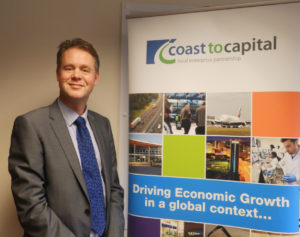Greater Brighton leaders have joined the fight for much-needed investment in the “outdated and creaking” Brighton Mainline.
Tens of thousands of commuters rely on the railway route from the south coast to London every day, making it crucial to businesses and future growth of the area.

Cllr Andy Smith, chairman of Greater Brighton, and Jonathan Sharrock, of Coast to Capital, mark GBEB supporting the Brighton Main Line alliance
But, with the 1960s infrastructure creaking under record numbers of passengers, business leaders, political leaders and national voices have united under a single banner of the Brighton Mainline Alliance.
The Greater Brighton Economic Board, which represents local authorities, businesses and academia, has now signed up to the campaign and pledged to support the ongoing mission of lobbying the Chancellor and transport secretary on what benefits an upgrade would bring.
Councillor Andy Smith, chairman of Greater Brighton Economic Board, said: “The Brighton Mainline is not just a commuter line; it is an essential transport corridor which is crucial to the economic development of our City Region.
“For too long now there has been severe under-investment in the infrastructure meaning the outdated line is creaking under the pressure. Combined with the chaos brought about by the industrial dispute in recent years, the situation faced by commuters and businesses is close to unbearable.
“The time to act is now, which is why I’m delighted to say that every member of Greater Brighton is unanimous in calling for funding to improve connectivity and reliability. In turn, this will unlock greater investment and ensure we can create more jobs, more homes and greater prosperity for our 900,000 residents.”
The decision was taken at a meeting of the GBEB board this week.
Members heard how passenger journeys on Southern and Thameslink services have risen by 10% to 105 million per annum in the past five years.
 With the Greater Brighton economy growing year-on-year, Network Rail predict increasingly severe crowding on trains, driven by the region’s growing economy.
With the Greater Brighton economy growing year-on-year, Network Rail predict increasingly severe crowding on trains, driven by the region’s growing economy.
The fundamental obstacle to increased capacity and resilience on the Brighton Mainline is the bottleneck in the Windmill Bridge Junction area to the north of East Croydon.
Greater Brighton leaders backed the call for a redesign of this junction to be made a priority. It also supports the Brighton Mainline Alliance’s calls for two new platforms at East Croydon which will reduce congestion.
The direct benefits of upgrading the line include:
- More trains per hour at peak time (from 36 today increased to 42-44);
- Opportunity to run new services;
- Increased service reliability, addressing the “poor and unreliable condition” of the network as identified by the Gibb report;
- Value for money (estimated benefits of £2.40 to every £1 spent);
- Commercial opportunities to redevelop stations, particularly at East Croydon;
- Encouraging balanced economic growth by bringing businesses out from London
 More than 40 regional business groups and more than a dozen influential MPs have backed Coast to Capital Local Enterprise Partnership’s Brighton Mainline Alliance so far.
More than 40 regional business groups and more than a dozen influential MPs have backed Coast to Capital Local Enterprise Partnership’s Brighton Mainline Alliance so far.
The aim is to bring together voices from politics, business and education to develop a united voice when lobbying for investment.
The next step is developing a plan to present to Chancellor and transport secretary ahead of Network Rail making a decision on future spending plans.
Jonathan Sharrock, Chief Executive at Coast to Capital said: “Support from the Greater Brighton Economic Board is vital to the success of the Brighton Mainline Alliance and we are thrilled to have their backing.
“The Brighton Mainline proposal for investment in Windmill Bridge junction is a strong proposal which has been recommended by Network Rail and it is vital that we make the case to Government that this scheme is a priority and that it is approved for strategic investment.
“We look forward to continuing to engage with groups such as the Greater Brighton Economic Board and businesses across the region in the near future.”

